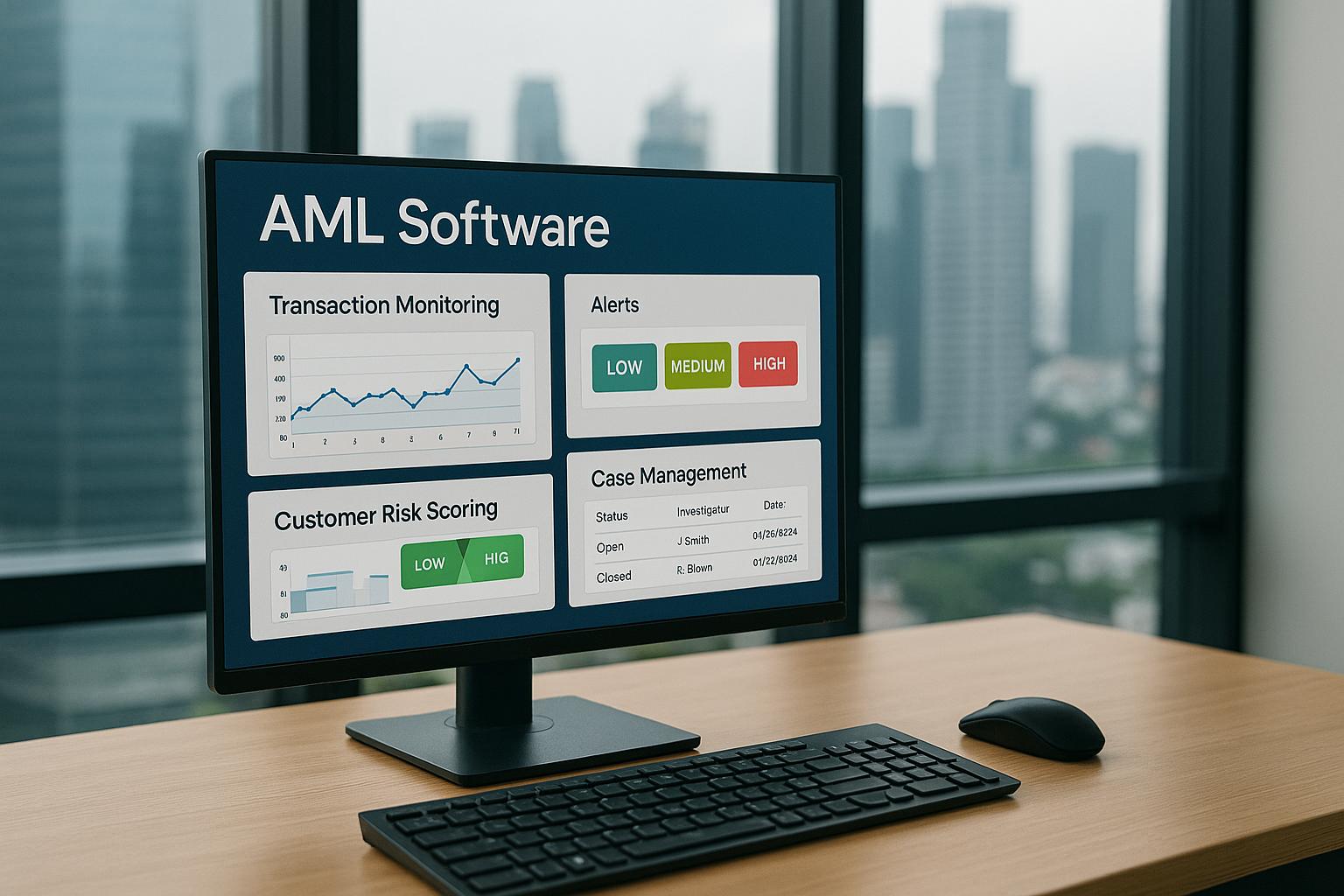Beyond the Ledger: How Transaction Monitoring Shields Banks from Financial Crimes
.svg)
In an era where financial crimes are increasingly sophisticated, bank transaction monitoring stands as a critical defence mechanism.
As digital banking evolves, the volume and complexity of transactions have surged, making it imperative for banks to employ advanced monitoring systems. These systems not only detect and prevent fraudulent activities in real-time but also ensure compliance with stringent regulatory standards. By analysing transaction patterns and customer behaviours, banks can swiftly identify anomalies, mitigate risks, and uphold the integrity of the financial system.
This article delves into the pivotal role of transaction monitoring in modern banking, exploring its functionalities, benefits, and the technological advancements that are shaping its future.
Understanding Bank Transaction Monitoring
Bank transaction monitoring is a crucial aspect of banking operations.
It involves the continuous tracking and analysis of all transactions that occur within a bank.
The primary purpose of this system is to detect and prevent fraudulent activities. It also helps banks comply with Anti-Money Laundering (AML) regulations and other compliance requirements.
In essence, transaction monitoring systems serve as a bank's first line of defence against financial fraud.
They are designed to identify unusual transaction patterns that may indicate suspicious activities, such as money laundering or identity theft.
{{cta-first}}
The Importance of Real-Time Monitoring
In today's fast-paced digital world, real-time monitoring is more important than ever.
It allows banks to detect suspicious activities as they occur, rather than after the fact. This prompt detection is crucial in preventing financial fraud and mitigating potential losses.
Real-time monitoring also enhances customer service. It enables banks to quickly address any issues or concerns that may arise during a transaction.
In essence, real-time monitoring contributes significantly to the overall security and efficiency of banking operations.
How Transaction Monitoring Systems Work
Transaction monitoring systems are complex, but their operation can be broken down into a few key steps:
- Data Collection: The system collects data from various sources, including transaction records, customer profiles, and external databases.
- Data Analysis: The system analyses the collected data to identify patterns and trends. It uses advanced algorithms and machine learning techniques to detect any unusual or suspicious activities.
- Alert Generation: If the system detects a potential issue, it generates an alert. This alert is then reviewed by a team of analysts for further investigation.
- Investigation and Reporting: If the analysts confirm that the alert indicates a genuine issue, they take appropriate action. This may involve contacting the customer, reporting the issue to the relevant authorities, or blocking the transaction.
- Continuous Improvement: The system continuously learns from the data it processes. This enables it to improve its detection capabilities over time and adapt to new types of fraud.
In essence, a transaction monitoring system is a powerful tool that helps banks maintain the integrity of their operations and protect their customers' financial assets.
Benefits of Transaction Tracking for Banks and Customers
Transaction tracking offers numerous benefits for both banks and their customers.
For banks, it enhances security by detecting and preventing fraudulent activities. It also helps banks comply with regulatory requirements, reducing the risk of penalties and reputational damage.
For customers, transaction tracking provides peace of mind. They can be confident that their financial transactions are being monitored for any signs of fraud.
Moreover, transaction tracking can improve the customer experience. It allows banks to quickly address any issues that may arise, enhancing customer satisfaction and loyalty.
Enhancing Security and Compliance
Transaction tracking plays a crucial role in enhancing the security of banking operations.
By detecting unusual transaction patterns it helps prevent financial fraud. This includes activities such as money laundering, identity theft, and credit card fraud.
Moreover, transaction tracking helps banks comply with regulatory requirements. This includes Anti-Money Laundering (AML) regulations, Know Your Customer (KYC) requirements, and other compliance standards.
Building Trust and Reputation
Transaction tracking also contributes to building trust and reputation.
For customers, knowing that their transactions are being monitored can provide peace of mind. This can enhance their trust in the bank and their willingness to use its services.
For banks, a robust transaction monitoring system can enhance their reputation. It can demonstrate their commitment to security and compliance, attracting more customers and fostering loyalty among existing ones.
Best Practices for Implementing Transaction Monitoring Systems
Implementing a transaction monitoring system is a complex process. It requires careful planning and execution.
One best practice is to customise the system to the specific needs of your institution. This includes setting appropriate rules and thresholds for detecting suspicious transactions.
Another best practice is to integrate the system with other compliance functions. This can enhance the effectiveness of the monitoring process.
Here are some key best practices for implementing transaction monitoring systems:
- Customize the system to your institution's needs.
- Integrate the system with other compliance functions.
- Train staff on how to use the system effectively.
- Regularly update the system to reflect changes in regulations and risk profiles.
- Monitor the system's performance and make adjustments as needed.
- Maintain a robust audit trail of all monitoring activities.
Customising Rules and Thresholds for Your Institution
Customising the rules and thresholds of your transaction monitoring system is crucial. This ensures that the system is tailored to the specific risk profile of your institution and its customers.
For example, you might set lower thresholds for high-risk customers. This would trigger alerts for smaller transactions that might otherwise go unnoticed.
On the other hand, setting the thresholds too low can result in a high number of false positives. This can overwhelm your staff and reduce the effectiveness of the monitoring process.
In essence, customising the rules and thresholds of your transaction monitoring system is a delicate balancing act. It requires a deep understanding of your institution's risk profile and the transaction patterns of your customers.
Challenges and Considerations in Transaction Monitoring
Implementing a transaction monitoring system is not without its challenges.
One of the main challenges is ensuring data quality. Transaction monitoring systems rely on accurate and complete data to detect unusual patterns. However, maintaining data quality can be a complex and resource-intensive task.
Another challenge is managing customer privacy concerns. While transaction monitoring is crucial for security, it also involves collecting and analysing sensitive customer data. Banks must ensure that they handle this data responsibly and comply with privacy regulations.
Finally, banks must also consider the cost implications. Implementing a robust transaction monitoring system can be a significant investment. However, the cost of not having an effective system – in terms of financial losses and reputational damage – can be much higher.
Balancing Automation and Human Oversight
Balancing automation and human oversight is another key consideration in transaction monitoring.
While automation can enhance efficiency and accuracy, it cannot completely replace human judgment. For instance, automated systems may generate false positives, flagging legitimate transactions as suspicious.
Therefore, it's crucial to have human oversight to review these alerts. This can help ensure that legitimate transactions are not unnecessarily blocked and that suspicious activities are properly investigated.
The Future of Transaction Monitoring in Banking
The future of transaction monitoring in banking is promising. With advancements in technology, banks can now monitor transactions more effectively and efficiently.
Artificial intelligence and machine learning are playing a significant role in this evolution. These technologies can analyse vast amounts of data quickly, identify patterns, and learn from them. This can help banks detect suspicious activities more accurately and reduce false positives.
Moreover, as digital banking continues to grow, the importance of robust transaction monitoring systems will only increase. Banks that invest in these systems will be better equipped to manage risks and protect their customers.
{{cta-ebook}}
Technological Advancements and Trends
Several technological advancements and trends are shaping the future of transaction monitoring.
One of these is the use of predictive analytics. This involves using historical data to predict future behaviour. For instance, banks can use predictive analytics to identify patterns of fraudulent activity and take preventive measures.
Another trend is the integration of transaction monitoring systems with other banking systems. This can provide a more holistic view of customer behaviour and enhance the effectiveness of monitoring.
Finally, the rise of open banking and API-driven financial services is also influencing transaction monitoring. This trend is enabling more seamless and secure data sharing, which can enhance monitoring capabilities.
In conclusion, bank transaction monitoring is a critical aspect of modern banking operations. It helps in detecting and preventing fraudulent activities, ensuring regulatory compliance, and enhancing customer trust.
As technology continues to evolve, banks must stay ahead by continuously improving their transaction monitoring systems. This will not only protect them from financial risks but also help them deliver better services to their customers.
As we have explored, transaction monitoring is an indispensable component of today's banking landscape, offering robust protection against fraud and compliance breaches. As financial institutions continue to face evolving threats, leveraging advanced solutions becomes paramount. Tookitaki's Transaction Monitoring solution offers innovative tools designed to meet these challenges head-on, ensuring both security and efficiency. We invite you to contact us to learn more about how Tookitaki can enhance your bank's transaction monitoring capabilities and fortify your defences against financial crimes.
Experience the most intelligent AML and fraud prevention platform
Experience the most intelligent AML and fraud prevention platform
Experience the most intelligent AML and fraud prevention platform
Top AML Scenarios in ASEAN

The Role of AML Software in Compliance

The Role of AML Software in Compliance










